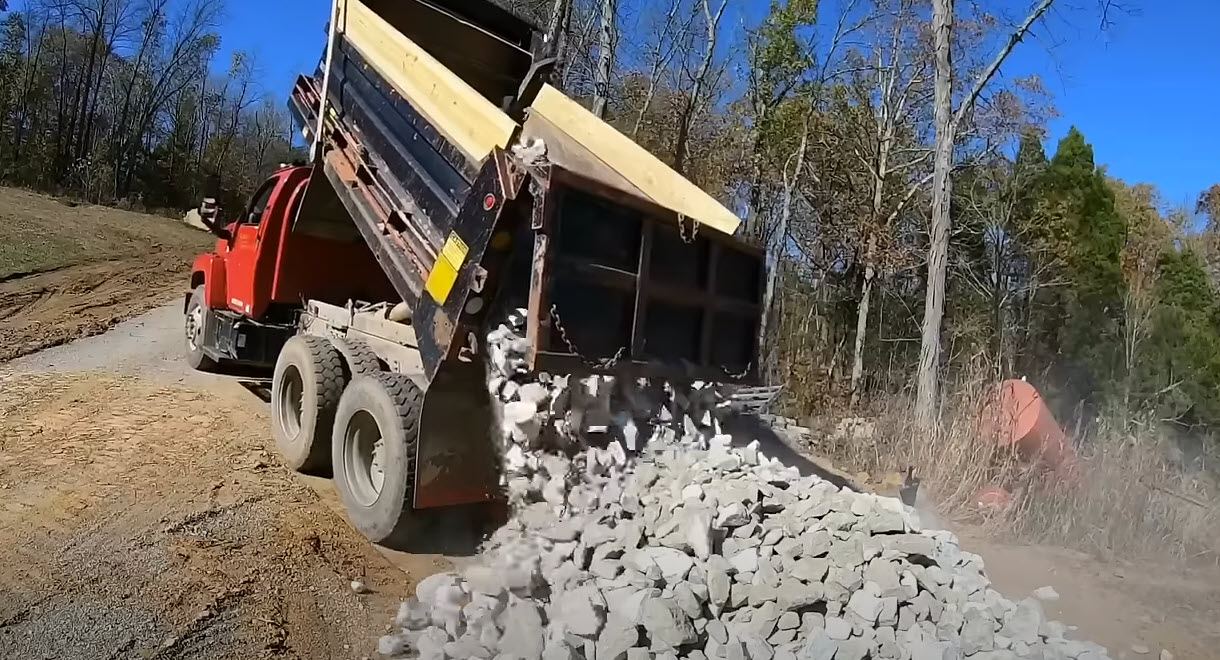Rock Trucking Servicesin Saint Clair Shores MI
Rock Trucking Solutions for Safe and Timely Delivery
We Are Locally Owned & Operated For Over 37 Years
Contact Us Today!
We Serve Businesses In And Around The Following Cities:
About Rock Trucking Services
Introduction
When it comes to large-scale commercial properties in Saint Clair Shores, the importance of efficient construction methods can never be overemphasized. Among these, rock truck services provide an irreplaceable role in site preparation, landscaping, and construction. A rock truck, a giant of the construction industry, is a substantial investment that plays a crucial role in supportive infrastructure construction, which directly impacts the timelines and efficiencies of commercial property developments. Rock hauling services provide businesses a turnkey solution that is both practical and advantageous, and this guide is designed to give a comprehensive overview of these benefits and real-world applications.
The Process of Rock Truck Services
The rock truck process is a straightforward one that focuses on the efficient delivery of large volumes of rocks and other materials to desired locations. Companies like D&J Contracting, a regional leader in rock hauling services, often possess fleets of rock trucks with payloads varying from tens to hundreds of tons. Following a set schedule, these rock trucks transport and distribute the required material to designated locations. Given their enormous capacity, rock trucks support immediate construction needs and can save considerable time and effort when compared to alternative means of transportation.
Benefits of Rock Truck Services
The utilization of rock truck services offers numerous benefits, especially for commercial properties. Firstly, there is the convenience factor. By utilizing a service like the one provided by D&J Contracting, businesses can quickly address their immediate construction needs without the hassle of sourcing, transporting, and delivering materials themselves. This not only saves time but also reduces the potential for delays due to logistical challenges.
Secondly, rock truck services are cost-effective. Companies that provide rock hauling services have economies of scale in their favor. As a result, clients can often enjoy significantly lower costs compared to the expense of attempting similar operations in-house. Furthermore, these cost benefits extend far beyond the initial delivery, as the more expedient construction and site preparation process facilitated by rock truck services lead to further financial and time savings down the line.
Real-World Applications of Rock Truck Services
In the world of commercial properties, rock hauling services find applications in a diverse range of scenarios. These include, but are not limited to, groundwork in infrastructure and high-rise projects, terrain stabilization, landscaping efforts, and so on. Companies in Saint Clair Shores like D&J Contracting understand local requirements and regulations, and therefore can help guide commercial property owners through the necessary processes for successful project completion.
Take for instance a commercial property which needs land leveling for its new parking lot. A rock truck, in such scenarios, provides a quick and efficient solution. Similarly, in another instance of constructing a new commercial building, rock trucks play a crucial role in the excavation and grading process.
D&J Contracting’s specialized fleet of rock trucks are also extensively used for beautification projects in commercial properties like decorating large spaces with decorative rock features or creating rock gardens. These rock hauling services not only expedite the completion of such projects but also ensure the delivery of top-grade materials that aid in enhancing the aesthetic appeal of the property.
Making The Right Choice
In conclusion, the role that rock trucks play in the commercial property sector is far reaching and indispensable. When chosen wisely, rock hauling services can save businesses significant time and money—two resources always in high demand—while also ensuring the highest quality of work.
The importance of the local knowledge that companies like D&J Contracting bring to the table can never be overstated. Not only do they understand the specific requirements of the region, but they also offer decades of experience and a proven track record. By opting for rock truck services, commercial property owners in Saint Clair Shores can streamline their operations while ensuring the best possible results.
Navigating the process of commercial property development can be a complex task, and experts in the field can take a lot of weight off your shoulders. Whether you are planning a new project or have specific rock hauling needs, it may be time to consider a service like D&J Contracting’s to elevate your project to the next level. Remember that every decision in the construction process matters for the overall cost, the project timeline, and most importantly, the final result.
Rock Trucking Services Gallery


Call Us Today to receive your Free Quote for
Rock Truck in Saint Clair Shores
Serving: Saint Clair Shores, Michigan

About Saint Clair Shores, Michigan
|
|
This section does not cite any sources. (February 2019)
|
Located along the shores of Lake St. Clair and inhabited by French settlers as early as 1710, during which time the area was referred to as L’anse Creuse, the future St. Clair Shores would remain mainly a rural farming area populated by largely French and German immigrant families into the early 20th century. These local family surnames have survived into the 21st century and can be found in the surnames of current residents and among numerous residential street names.
From 1835 until 1843, the area was part of Orange Township, among the first townships platted in Michigan and part of Macomb County. In 1843, Orange Township was renamed Erin Township, in homage to the numerous Irish immigrants who had moved into the area and had begun to exert their political influence. From 1843 until 1911, what is now St. Clair Shores was a part of Erin Township, parts of which make up today’s municipalities of Eastpointe, Roseville, and St. Clair Shores.
In 1911, the eastern portion of Erin Township was partitioned off to become Lake Township. St. Clair Shores was incorporated as a village in 1925 and remained a part of Lake Township until, after numerous failed attempts, its residents voted to incorporate as the city of St. Clair Shores in January 1951. Lake Township continued adjacent to the city until 2009, when residents of the village of Grosse Pointe Shores (that portion of Grosse Pointe Shores in Macomb County located within Lake Township) voted to incorporate as a city.
Beginning around the time of the First World War, St. Clair Shores became a favored playground for gamblers, rum runners, and lakefront tourists alike, culminating during Prohibition, but continuing through the Second World War era. During these years, the village was the home to many popular roadhouses, blind pigs, and gambling establishments, such as the Blossom Heath Inn. St. Clair Shores’ lakefront location and proximity to Canada coupled with a receptive and often participative community made it an advantageous haven for rum runners, and the area was actively involved in the rum-running era of Prohibition. Local residents, politicians, and law enforcement of the era were known to sometimes conflict with both state and federal officials over their attempts to regulate these illegal, but economically vital, activities within the community.
The Eagle Pointe subdivision, one of many platted within the village of St. Clair Shores during the early 20th century, was platted along a part of the lake shore in 1916. During the next few decades, dozens of subdivisions were platted through the local farmland, but most were not developed in earnest until after the Second World War, when St. Clair Shores became the fastest-growing suburb of Detroit during the 1950s.
From 1927 until 1959, the community was the location of the Jefferson Beach Amusement Park, a major lakefront attraction for the Detroit area and beyond. Opened in 1927, it boasted the longest roller coaster in the United States and numerous other midway attractions, a large, ornate lakefront dance pavilion, and a large, sandy beach popular with swimmers and sun bathers. In 1955, a fire destroyed some of the attractions and buildings within the once-popular park, and this, coupled with changing public tastes, accelerated its demise. While the owners of Jefferson Beach Amusement Park considered rebuilding, by this time the park was not popular with local government officials, and the city council had begun exploring forcing the closure of the facility or purchasing it for public use. Instead, the park owners, who had previously started building an onsite marina facility, began to expand that part of the facility. By 1959, the remaining park amusements and buildings were demolished to make room for the greatly enlarged Jefferson Beach Marina. All that remained of the once grand amusement park was its large, ornate lakefront dance coliseum, which for years thereafter was relegated to use as a marina storage facility and marine supply store until it, too, was destroyed by fire.
St. Clair Shores is in southern Macomb County, on the western side of Lake St. Clair. It is bordered to the west by the cities of Roseville and Eastpointe and to the south, in Wayne County, by Harper Woods, Grosse Pointe Woods, and Grosse Pointe Shores. Interstate 94 runs along the western edge of the city, with access from Exits 224 through 230. I-94 leads southwest 13 miles (21 km) to midtown Detroit and northeast 40 miles (64 km) to Port Huron.
According to the U.S. Census Bureau, St. Clair Shores has a total area of 14.40 square miles (37.30 km), of which 2.72 square miles (7.04 km), or 18.9%, are covered by water. The city has 14 miles (23 km) of canals. Most of these canals are found in the Nautical Mile, which is along Jefferson between 9 Mile and 10 Mile Roads.
| Census | Pop. | Note | %± |
|---|---|---|---|
| 1930 | 6,745 | — | |
| 1940 | 10,405 | 54.3% | |
| 1950 | 19,823 | 90.5% | |
| 1960 | 76,657 | 286.7% | |
| 1970 | 88,093 | 14.9% | |
| 1980 | 76,210 | −13.5% | |
| 1990 | 68,107 | −10.6% | |
| 2000 | 63,096 | −7.4% | |
| 2010 | 59,715 | −5.4% | |
| 2020 | 58,874 | −1.4% | |
| U.S. Decennial Census 2018 Estimate |
|||
As of the census of 2010, there were 59,715 people, 26,585 households, and 15,932 families living in the city. The population density was 5,139.0 inhabitants per square mile (1,984.2/km). There were 28,467 housing units at an average density of 2,449.8 per square mile (945.9/km). The racial makeup of the city was 92.7% White, 3.9% African American, 0.3% Native American, 1.0% Asian, 0.2% from other races, and 1.7% from two or more races. Hispanic or Latino residents of any race were 1.7% of the population.
Of the 26,585 households, 24.6% had children under 18 living with them, 43.6% were married couples living together, 11.9% had a female householder with no husband present, 4.4% had a male householder with no wife present, and 40.1% were not families. About 35.1% of all households were made up of individuals, and 15.5% had someone living alone who was 65 or older. The average household size was 2.24, and the average family size was 2.90.
The median age in the city was 44.2 years; 19% of residents were under 18; 7% were between18 and 24; 24.9% were from 25 to 44; 29.7% were from 45 to 64; and 19.2% were 65 or older. The gender makeup of the city was 47.8% male and 52.2% female.
As of the census of 2000, 63,096 people, 27,434 households, and 17,283 families were living in the city. The population density was 5,472.3 inhabitants per square mile (2,112.9/km). The 28,208 housing units had an average density of 2,446.5 per square mile (944.6/km). The racial makeup of the city was 96.89% White, 0.69% African American, 0.28% Native American, 0.84% Asian, 0.20% from other races, and 1.10% from two or more races. Hispanic or Latino residents of any race were 1.18% of the population.
Of the 27,434 households, 24.1% had children under 18 living with them, 49.5% were married couples living together, 10.0% had a female householder with no husband present, and 37.0% were not families. About 32.7% of all households were made up of individuals, and 16.3% had someone living alone who was 65 years of age or older. The average household size was 2.28 and the average family size was 2.92.
In the city, the age distribution was 20.2% under 18, 6.2% from 18 to 24, 28.8% from 25 to 44, 23.1% from 45 to 64, and 21.8% who were 65 or older. The median age was 42 years. For every 100 females, there were 90.9 males. For every 100 females 18 and over, there were 86.8 males.
The median income for a household in the city was $49,047, and for a family was $59,245. Males had a median income of $46,614 versus $31,192 for females. The per capita income for the city was $25,009. About 2.6% of families and 3.7% of the population were below the poverty line, including 4.4% of those under 18 and 4.9% of those 65 or over.
St. Clair Shores has three school districts: South Lake Schools, which serves the southern portion of the city, Lakeview Public Schools, which serves the central portion of the city, and Lake Shore Public Schools, which serves the northern portion of the city. Each district operates one high school within the city.
Private, parochial schools include St. Germaine, St. Isaac Jogues, and St. Joan of Arc.
Call Us Today to receive your Free Quote for
Rock Truck in Saint Clair Shores
Related Services in Saint Clair Shores, Michigan
We Serve Businesses In The Following Zip Codes:
48007, 48015, 48021, 48026, 48035, 48036, 48038, 48042, 48043, 48044, 48045, 48046, 48047, 48048, 48050, 48051, 48066, 48071, 48080, 48081, 48082, 48083, 48084, 48085, 48088, 48089, 48090, 48091, 48092, 48093, 48098, 48099, 48225, 48230, 48236, 48310, 48311, 48312, 48313, 48314, 48315, 48316, 48317, 48318, 48397